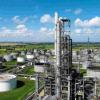I am working on improving the bulk density of various phosphate products during spray drying. All most all products Bulk density is close to 1 except dipotassium phospahte. I tried to do all the possibilties like increasing the inlet air temp, maintaining higher outlet temp, incresing the atomiser speed and reducing the feed. But none of the above have given me a break through. At present Bulk density of DKP(dipotassium phospahte) is 0.3 to 0.4. I could obsserve one thing that out of all the products DKP has very high solubility hence inlet feed % solids are always maintained high as it doest crystalise so easilty. Is there any relation that for some solutions feed % solids should be less to get high Bulk density? generally bulk density increases with increase in % solids. is there any relation or thumb rule to maintain feed conditions depending on specific feed ? or relation between molecular weight and feed solids or Bulk density?
If you have come across such problem then kindly share your ideas. This topic is very less discessed.
I need your inputs
Bye
Ajit

 FB
FB











